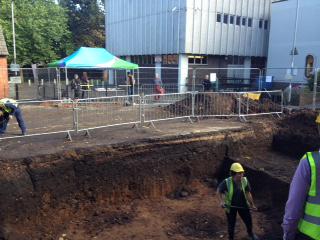Hundreds attend dig open days at Tamworth Assembly Rooms

Hundreds of people got a first-hand glimpse into Tamworth’s history during two open days at the site of the town’s archaeological dig next to Tamworth Assembly Rooms.
A team of experts from Wessex Archaeology spent over two weeks excavating the site of the former car park in Corporation Street to search for ancient artefacts before the land is built upon as part of the redevelopment of the historic theatre.
During the dig, archaeologists found four pits which are believed to have been used as rubbish dumps in medieval times. A number of items were found in those pits, including animal bones, several pieces of pottery and a carved piece of bone thought to have been the handle of a knife.
Although archaeologists will now be carrying out a more in-depth analysis, all the finds are believed to date from the 12th and 13th centuries, towards the end of the Middle Ages.
Members of the public were invited to learn more about the discoveries and speak to archaeologists during two open days at the site. Hundreds of people took the opportunity to get a unique glimpse into everyday life in Tamworth hundreds of years ago.
Wessex Archaeology Project Manager, Chris Swales, said: “The team from Wessex Archaeology were delighted to work with Tamworth Borough Council on the excavation and engage with local residents during two very successful open days. The excavations found several large rubbish pits within the footprint of the new development at the Assembly Rooms.
“Initial dating of the finds recovered from the pits suggests a medieval use of the site. Over the course of the next few weeks additional analysis will take place on all of the finds recovered from the excavation, as well as examining environmental samples taken from the fill of the rubbish pits.
“It is hoped that this work will allow us to shed more light on the use of the site by its medieval residents. Wessex Archaeology will continue to monitor the groundworks undertaken as part of the new development with the aim of recording any further archaeological features which may be exposed.”
Cllr Steve Claymore, Tamworth Borough Council’s Cabinet member for Regeneration, said: “Although it’s a shame we didn’t find the next Staffordshire Hoard, the dig was a very interesting exercise which turned up some fascinating finds that have been lying under our feet for hundreds of years.
“It also gave people the unique opportunity to see an excavation in progress in their home town and to find out more about archaeology.
“The completion of the dig means we can now prepare for the redevelopment of Tamworth Assembly Rooms, which will secure our historic theatre for future generations.”
The Assembly Rooms regeneration is part of the ambitious £6.1million project by Tamworth Borough Council and Staffordshire County Council, and part funded by the Heritage Lottery Fund, to develop an Enterprise Quarter in the heart of Tamworth town centre.
Work to the historic theatre will include the creation of a café bar and exhibition space, a multi-use area, a new box office and new glazed double doors at the front of the building.
A brand new glass extension will be added onto the side of the building which will be used as a studio space and lit up at night.
As well as the refurbishment and extension of Tamworth Assembly Rooms, the Enterprise Quarter vision includes the transformation of the Philip Dix Centre into a Business and Enterprise Centre, the redevelopment of the Carnegie Centre as a restaurant and improvements to the library and surrounding area to create a new cultural hub.
The project will create around 100 jobs, attract additional private investment and could potentially boost the town’s economy by an estimated £13million by 2019.







